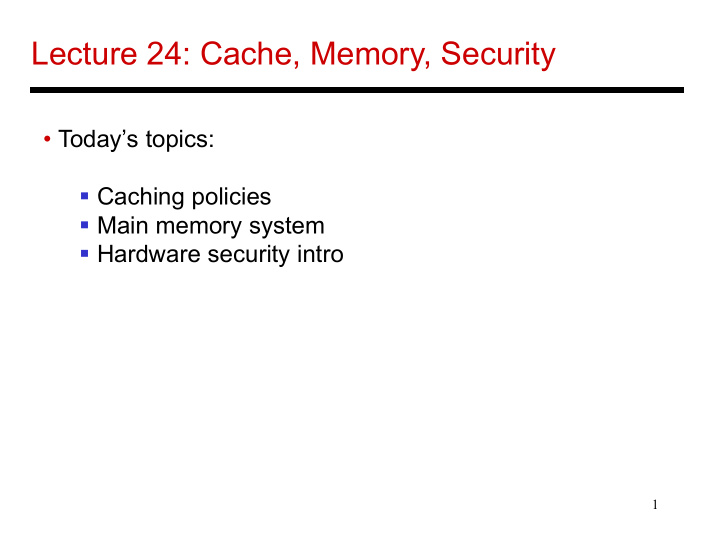



Lecture 24: Cache, Memory, Security • Today’s topics: Caching policies Main memory system Hardware security intro 1
Cache Misses • On a write miss, you may either choose to bring the block into the cache (write-allocate) or not (write-no-allocate) • On a read miss, you always bring the block in (spatial and temporal locality) – but which block do you replace? no choice for a direct-mapped cache randomly pick one of the ways to replace replace the way that was least-recently used (LRU) FIFO replacement (round-robin) 2
Writes • When you write into a block, do you also update the copy in L2? write-through: every write to L1 write to L2 write-back: mark the block as dirty, when the block gets replaced from L1, write it to L2 • Writeback coalesces multiple writes to an L1 block into one L2 write • Writethrough simplifies coherency protocols in a multiprocessor system as the L2 always has a current copy of data 3
Types of Cache Misses • Compulsory misses: happens the first time a memory word is accessed – the misses for an infinite cache • Capacity misses: happens because the program touched many other words before re-touching the same word – the misses for a fully-associative cache • Conflict misses: happens because two words map to the same location in the cache – the misses generated while moving from a fully-associative to a direct-mapped cache 4
Off-Chip DRAM Main Memory • Main memory is stored in DRAM cells that have much higher storage density • DRAM cells lose their state over time – must be refreshed periodically, hence the name Dynamic • A number of DRAM chips are aggregated on a DIMM to provide high capacity – a DIMM is a module that plugs into a bus on the motherboard • DRAM access suffers from long access time and high energy overhead 5
Memory Architecture Processor Bank Row Buffer Memory Controller Address/Cmd DIMM Data • DIMM: a PCB with DRAM chips on the back and front • The memory system is itself organized into ranks and banks; each bank can process a transaction in parallel • Each bank has a row buffer that retains the last row touched in a bank (it’s like a cache in the memory system that exploits spatial locality) (row buffer hits have a lower latency than a row buffer miss) 6
Hardware Security • Software security: key management, buffer overflow, etc. • Hardware security: hardware-enforced permission checks, authentication/encryption, etc. • Security vs. Privacy • Information leakage, side channels, timing channels • Meltdown, Spectre, SGX 7
Meltdown 8
Spectre: Variant 1 x is controlled by Thanks to bpred, x can be anything attacker array1[ ] is the secret if (x < array1_size) Victim y = array2[ array1[x] ]; Code Access pattern of array2[ ] betrays the secret 9
Spectre: Variant 2 Victim code R1 (from attacker) R2 some secret Attacker code Label0: if (…) Label0: if (1) … … Label1: … Victim code Label1: lw [R1] or lw [R2] 10
Recommend
More recommend